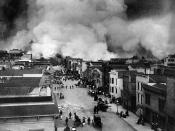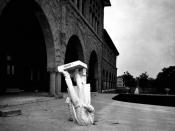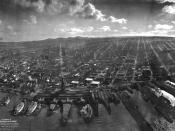The San Francisco earthquake of April 18, 1906 ranks as one of the most significant earthquakes of all time. Today, its importance comes more from the wealth of scientific knowledge derived from it than from its sheer size. Rupturing the northernmost 430 kilometers of the San Andreas Fault from northwest of San Juan Bautista to the triple junction at Cape Mendocino, the earthquake confounded contemporary geologists with its large, horizontal displacements and great rupture length. Indeed, the significance of the fault and recognition of its large cumulative offset would not be fully appreciated until the advent of plate tectonics more than half a century later. Analysis of the 1906 displacements and strain in the surrounding crust led Reid (1910) to formulate his elastic-rebound theory of the earthquake source, which remains today the principal model of the earthquake cycle.
The first shock -- at 5:12:05 a.m. -- lasted more than 40 seconds.
It was by far the largest, estimated to have been 8.3 on the Richter scale. Its center was just off the coast, around Pacifica. Two of the world's largest tectonic plates, the North American and the Pacific, had lurched past each other at a distance of between nine and 21 feet along the San Andreas Fault. The temblor shook the ground and left a wake of destruction 290 miles long -- from Mendocino to Monterey Counties -- with shock waves that traveled at over 7000 miles per hour.
In the city of San Francisco, it toppled chimneys and smokestacks, crumpled wood-frame houses into kindling, threw walls into the streets, and twisted steel rails and cast-iron ducts as if they were pipe cleaners. All the church bells in the city were set to clanging, as if signaling doomsday, the end of the world.
It was just before...



San Francisco earthquake
well written essay on San Francisco earthquake
0 out of 0 people found this comment useful.